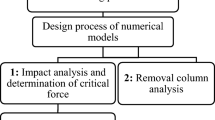Abstract
Structural integrity of either a passenger car or a light truck is one of the basic requirements for a full vehicle engineering and development program. The results of the vehicle product performance are measured in terms of durability, noise/vibration/harshness (NVH), crashworthiness and passenger safety. The level of performance of a vehicle directly affects the marketability, profitability and, most importantly, the future of the automobile manufacturer. In this study, we used the Virtual Proving Ground (VPG) approach for obtaining the dynamic stress or strain history and distribution. The VPG uses a nonlinear, dynamic, finite element code (LS-DYNA) which expands the application boundary outside classic linear, static assumptions. The VPG approach also uses realistic boundary conditions of tire/road surface interactions. To verify the predicted dynamic stress and fatigue critical region, a single bump run test, road load simulation, and field test have been performed. The prediction results were compared with experimental results, and the feasibility of the integrated life prediction methodology was verified.
Similar content being viewed by others
References
Baek, W. K., 1992, “A Study on Fatigue Life Prediction of Suspension Systems Using CAE,” KSAE Paper No. 923875.
DADS flex manual, CADSI, P.O. Box 203, Oakdale, Iowa 52319.
DADS users manual. CADSI. P.O. Box 203. Oakdale. Iowa 52319.
Han, D. H., et al., 2000, “Development and Comparative Study on Tire Models in the Au-toDyn7 Program,”KSME International Journal.
Kuo, E. Y. and Kelkar, S. G., 1995, “Vehicle Body Structure Durability Analysis,” SAE Paper No. 951096.
Papadrakakis, M., 1981, “A Method for the Automated Evaluation of the Dynamic Relaxation Parameter,” Comp. Meth. Appl. Mech. Eng. 25, pgs. 35–48
Shin, S. H. and Yoo, W. S., 2000, “Comparative Study of Dynamic Analysis Techniques in Vehicle Simulation,”KSME International Journal.
Zhang, Y. and Tang, A., 1996, “The CAE Revolution and the Development of the Virtual Proving Ground Approach,” The 4th International LS-DYNA Conference, Minneapolis, Minnesota. Sept.
Zhang, Y., et al., 1997, “Validation of a FEA Tire Model for Vehicle Dynamic Analysis and Full Vehicle Real Time Proving Ground Simulations,” SAE Paper No. 971100.
eta/VPG application manual, ETA. 1133 E. Maple Rd., suite 200 Troy. MI 48083 USA.
eta/VPG users processor manual, ETA, 1133 E. Maple Rd., suite 200 Troy, MI 48083 USA.
Author information
Authors and Affiliations
Corresponding author
Rights and permissions
About this article
Cite this article
Kim, G.H., Cho, K.Z., Chyun, I.B. et al. Dynamic Stress Analysis of Vehicle Frame Using a Nonlinear Finite Element Method. KSME International Journal 17, 1450–1457 (2003). https://doi.org/10.1007/BF02982324
Received:
Revised:
Published:
Issue Date:
DOI: https://doi.org/10.1007/BF02982324




